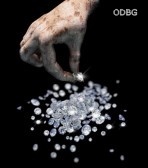|
Smart Jewelry Shopper How to Buy Jewelry & Gemstones With Confidence |
 |
Almost every solid material has a number of imperfections inside them; clarity is a measure of these. The more imperfections you can find in a diamond, the lower its quality and price will become. You should not think that a diamond with 3 minor imperfections is worthless or won't be beautiful to the eyes. The truth is, a very high number of dislocations (that is the scientific term for these imperfections) are needed to be there until you can observe any problem with your bare eyes. What Will Guide Me When it Comes Identifying Different Clarity Levels? There are international standards that help us define the quality of a given diamond. According to these standards, the clarity of diamonds can be classified into one of the following categories (from best to worst quality):
How Should I Interpret all These Different Classes?
Also, diamonds classified as I1, I2 or I3 are of so low quality that most jewelers will not allow them into their businesses; they would only lower the reputation of the store. Often, when you see jewelry stores selling diamonds at ridiculously low prices - (1 carat for $2000), chances are, these are the kind of diamonds that fall in I1 - I3 ranges. So, What Clarity Grading Should I Choose, After All? Most diamond buyers will probably want to choose diamonds from the VS1 and VS2 categories. Also, if your budget is tighter, choosing slightly included diamonds is still a viable option. To put your money to its best value, I would recommend you to purchase diamonds within the range of VS1 - SI2 that are eye-clean. The rest of the categories appear at the extreme ends: you will probably only find internal flawless diamonds in royal jewelry and you should only use very included diamonds to cut glass or other, more beautiful diamonds.
|
 |
|
 Apart from their shape, diamonds can be differentiated by taking a look at their major
characteristics, also known as the "four C's" of diamonds:
Apart from their shape, diamonds can be differentiated by taking a look at their major
characteristics, also known as the "four C's" of diamonds:  These categories are not too hard to learn and knowledge of them might come in handy. However,
when it comes to actually buying a diamond the situation is usually even simpler. The FL, IL and VVS
categories are so rare that you will probably not see much in store windows.
These categories are not too hard to learn and knowledge of them might come in handy. However,
when it comes to actually buying a diamond the situation is usually even simpler. The FL, IL and VVS
categories are so rare that you will probably not see much in store windows.